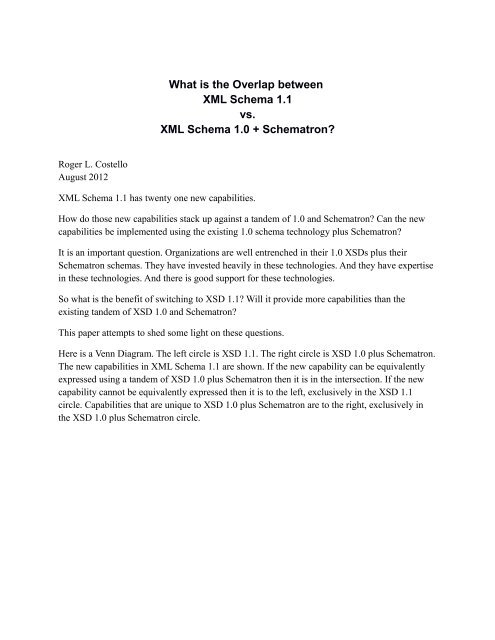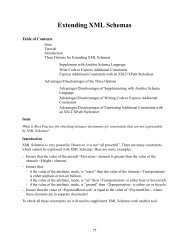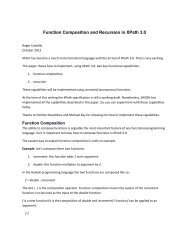Overlap between XML Schema 1.1 and XML Schema 1.0 + ... - xFront
Overlap between XML Schema 1.1 and XML Schema 1.0 + ... - xFront
Overlap between XML Schema 1.1 and XML Schema 1.0 + ... - xFront
Create successful ePaper yourself
Turn your PDF publications into a flip-book with our unique Google optimized e-Paper software.
What is the <strong>Overlap</strong> <strong>between</strong><br />
<strong>XML</strong> <strong>Schema</strong> <strong>1.1</strong><br />
vs.<br />
<strong>XML</strong> <strong>Schema</strong> <strong>1.0</strong> + <strong>Schema</strong>tron?<br />
Roger L. Costello<br />
August 2012<br />
<strong>XML</strong> <strong>Schema</strong> <strong>1.1</strong> has twenty one new capabilities.<br />
How do those new capabilities stack up against a t<strong>and</strong>em of <strong>1.0</strong> <strong>and</strong> <strong>Schema</strong>tron? Can the new<br />
capabilities be implemented using the existing <strong>1.0</strong> schema technology plus <strong>Schema</strong>tron?<br />
It is an important question. Organizations are well entrenched in their <strong>1.0</strong> XSDs plus their<br />
<strong>Schema</strong>tron schemas. They have invested heavily in these technologies. And they have expertise<br />
in these technologies. And there is good support for these technologies.<br />
So what is the benefit of switching to XSD <strong>1.1</strong>? Will it provide more capabilities than the<br />
existing t<strong>and</strong>em of XSD <strong>1.0</strong> <strong>and</strong> <strong>Schema</strong>tron?<br />
This paper attempts to shed some light on these questions.<br />
Here is a Venn Diagram. The left circle is XSD <strong>1.1</strong>. The right circle is XSD <strong>1.0</strong> plus <strong>Schema</strong>tron.<br />
The new capabilities in <strong>XML</strong> <strong>Schema</strong> <strong>1.1</strong> are shown. If the new capability can be equivalently<br />
expressed using a t<strong>and</strong>em of XSD <strong>1.0</strong> plus <strong>Schema</strong>tron then it is in the intersection. If the new<br />
capability cannot be equivalently expressed then it is to the left, exclusively in the XSD <strong>1.1</strong><br />
circle. Capabilities that are unique to XSD <strong>1.0</strong> plus <strong>Schema</strong>tron are to the right, exclusively in<br />
the XSD <strong>1.0</strong> plus <strong>Schema</strong>tron circle.
The following table shows in the left column the new capabilities in <strong>XML</strong> <strong>Schema</strong> <strong>1.1</strong> <strong>and</strong> in the<br />
right column it describes how to achieve the equivalent capability using a t<strong>and</strong>em of <strong>1.0</strong> plus<br />
<strong>Schema</strong>tron. If the <strong>1.1</strong> capability cannot be achieved using the t<strong>and</strong>em then it says so.<br />
New capability provided by<br />
<strong>XML</strong> <strong>Schema</strong> <strong>1.1</strong><br />
How to achieve the equivalent capability using a<br />
t<strong>and</strong>em of <strong>XML</strong> <strong>Schema</strong> <strong>1.0</strong> plus <strong>Schema</strong>tron<br />
1. This capability is readily achieved using <strong>Schema</strong>tron. In<br />
fact, <strong>Schema</strong>tron provides more capability than does the<br />
element because is limited just to one<br />
<strong>XML</strong> document, whereas <strong>Schema</strong>tron can make assertions<br />
across multiple <strong>XML</strong> documents.<br />
2. facet Again, <strong>Schema</strong>tron provides this capability, plus more.<br />
3. The equivalent capability can be achieved by the <strong>1.0</strong><br />
schema declaring an element of type, xs:anyType, <strong>and</strong> then
the <strong>Schema</strong>tron schema contains the rules, “If the value of<br />
the attribute is A then the content of the element must be<br />
xyz; if the value of the attribute is B then the content of the<br />
element must be wxy; <strong>and</strong> so forth”<br />
4. error data type Readily achieved using a <strong>Schema</strong>tron rule that checks for<br />
erroneous data.<br />
5. This can be achieved by adding elements<br />
everywhere open content is desired. This is not as clean as<br />
the element provided in XSD <strong>1.1</strong>.<br />
6. defaultAttributes The equivalent capability can be achieved by the <strong>1.0</strong><br />
schema declaring anyAttribute in each complexType <strong>and</strong><br />
then in <strong>Schema</strong>tron have rules that specify the allowable<br />
default attributes.<br />
7. vendor unique extensions <strong>and</strong><br />
facets<br />
8. vc:minVersion,<br />
vc:maxVersion,<br />
vc:typeAvailable,<br />
vc:typeUnavailable,<br />
vc:facetAvailable,<br />
vc:facetUnavailable<br />
The equivalent capability can be achieved by the <strong>1.0</strong><br />
schema declaring an element of type string <strong>and</strong> then in<br />
<strong>Schema</strong>tron specify the rules for the extensions <strong>and</strong> facets.<br />
These cannot be achieved using a t<strong>and</strong>em of XSD <strong>1.0</strong> <strong>and</strong><br />
<strong>Schema</strong>tron. However, vc is probably not useful until there<br />
are more versions of <strong>XML</strong> <strong>Schema</strong>.<br />
9. inheritable attributes Readily achieved using a <strong>Schema</strong>tron rule that has<br />
assertions which take into account the value of attributes<br />
anywhere in the <strong>XML</strong> document, even across <strong>XML</strong><br />
documents.<br />
10<br />
.<br />
enhanced element Readily achieved by using a repeatable <strong>and</strong> then<br />
using <strong>Schema</strong>tron rules to enforce cardinality.<br />
11. enhanced substitutionGroup Readily achieved by replacing the substitutionGroup with<br />
an XSD <strong>1.0</strong> element.<br />
12 new attributes of <strong>and</strong> Readily achieved through the use of <strong>Schema</strong>tron rules.<br />
. <br />
13<br />
.<br />
more flexible rules for<br />
wildcards<br />
This cannot be achieved using a t<strong>and</strong>em of XSD <strong>1.0</strong> <strong>and</strong><br />
<strong>Schema</strong>tron.<br />
14<br />
.<br />
Declare multiple attributes to be of type string <strong>and</strong> then<br />
use <strong>Schema</strong>tron to enforce uniqueness.<br />
15<br />
.<br />
16<br />
.<br />
17<br />
.<br />
element can have multiple<br />
attributes of type ID <strong>and</strong> the<br />
ID type can have a fixed or<br />
default value<br />
<br />
enhanced targetNamespace<br />
enables a complexType to<br />
restrict a complexType in<br />
another namespace<br />
anyAtomicType<br />
This cannot be achieved using a t<strong>and</strong>em of XSD <strong>1.0</strong> <strong>and</strong><br />
<strong>Schema</strong>tron.<br />
This cannot be achieved using a t<strong>and</strong>em of XSD <strong>1.0</strong> <strong>and</strong><br />
<strong>Schema</strong>tron.<br />
Declare an element to be of type anyType, <strong>and</strong> then apply<br />
<strong>Schema</strong>tron rules to ensure the element’s value is
18<br />
.<br />
19<br />
.<br />
20<br />
.<br />
21<br />
.<br />
dateTimeStamp<br />
yearMonthDuration<br />
dayTimeDuration<br />
explicitTimezone facet<br />
anyAtomicType.<br />
Declare the item to be of type dateTime <strong>and</strong> then use<br />
<strong>Schema</strong>tron to verify the dateTime value has a time zone<br />
value.<br />
Declare the item to be of type duration <strong>and</strong> then use<br />
<strong>Schema</strong>tron to verify the duration value contains just years<br />
<strong>and</strong> months.<br />
Declare the item to be of type duration <strong>and</strong> then use<br />
<strong>Schema</strong>tron to verify the duration value contains just day<br />
<strong>and</strong> time.<br />
Use <strong>Schema</strong>tron to check that the value specifies a<br />
timezone.






